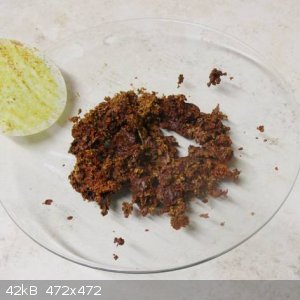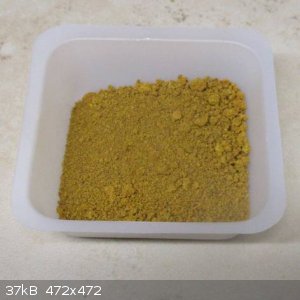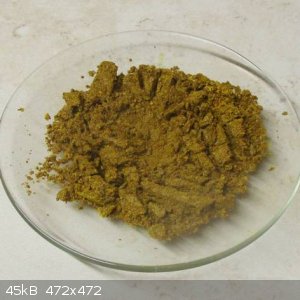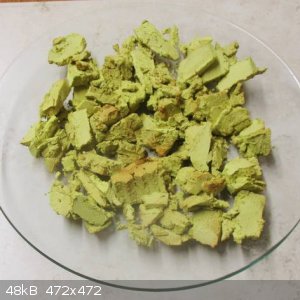Boffis
International Hazard
    
Posts: 1838
Registered: 1-5-2011
Member Is Offline
Mood: No Mood
|
|
Anthraquinone preparations
While searching the web for some old German patents related to anthraquinone and its derivatives I came across an interesting patent that describes
the oxidation of anthracene to anthraquimnone using fused nitrates. The reaction uses low melting point, hydrated nitrate salts such as aluminium and
zinc nitrates. Auminium nitrate seems to be the preferred nitrate due to its low melting point and in the examples presented in the patent it
describes the use of aluminium nitrate at boiling-water bath temperature ie <100 C for an hour or an oil bath at 120-130 C for 10 minute. I have
attached a translation of the patent below.
Having now acquired some technical grade anthracene (~90%), I decided to give it a try. I was a bit concerned with the idea of fusing a fuel with a
nitrate oxidiser so I tried the experiment with just 1g of anthracene and 3g of aluminium nitrate hydrate in a test-tube first. I fused the mixture in
a spirit lamp flame and kept it molten for about 20 minute but without any temperature control. The mixture was stirred with a bit of iron wire since
the molten organic phase doesn't mix well with the fused inorganic layer. When cooled it set like glass and to remove it from the tube I had to fuse
it again and add 4ml of 2M hydrochloric acid. The brown vesicular slag like material was filtered off, washed with dilute HCl and then water and
finally dried at 45C overnight (at higher tempertures it became plastic).
Th brown product weighed 1.052g but there was considerable loss due to material adhering to the test-tube. In an attempt to purify the material it was
recrystallised from 15ml of glacial acetic acid to give 0.448g of golden yellow needles containing a few dark red-brown platy crystals. In the belief
that the red crystals were a hydroxyanthraquinone forme by over oxidation I tried leaching the product with sodium hydroxide solution (2M) but no
obvious solution occurred and certainly no red or violet colour typical of hydroxyanthraquinones.
So the reaction looks at least credible but I can see that considerable purification is going to be required. I the patent the anthrquinone is
evaporated from the reaction mixture using superheated steam or hot air but this is not practical for most amateurs.
I am currently running a larger scal experiment using 10.006g and 28.36g of aluminium nitrate; report to follow.
|
|
|
Lionel Spanner
Hazard to Others
  
Posts: 163
Registered: 14-12-2021
Location: near Barnsley, UK
Member Is Offline
|
|
Looking forward to it - if it works well, this method could prove to be very practical.
|
|
|
Boffis
International Hazard
    
Posts: 1838
Registered: 1-5-2011
Member Is Offline
Mood: No Mood
|
|
Ah. Forgot to attach the patent number and the translation!
The patent is DE 568784.
Attachment: Oxidation of anthracene to anthraquinone in molten nitrates DE 568784 English.docx (15kB)
This file has been downloaded 72 times
|
|
|
Diachrynic
Hazard to Others
  
Posts: 219
Registered: 23-9-2017
Location: western spiral arm of the galaxy
Member Is Offline
Mood: zenosyne
|
|
As an alternative, this preparation from Orgsyn looks less dangerous than molten nitrate: H. W. Underwood, Jr., W. L. Walsh., Org. Synth.
1936, 16, 73, https://doi.org/10.15227/orgsyn.016.0073
| Quote: | | By the use of a suitable organic solvent the same oxidizing agent can be employed for the preparation of anthraquinone. A mixture of 90 g. (0.51 mole)
of finely powdered pure anthracene, 0.5 g. of vanadium pentoxide, 76 g. of sodium chlorate, 1 l. of glacial acetic acid, and 200 cc. of 2 per cent
sulfuric acid is warmed under reflux until a vigorous reaction commences. The source of heat is removed, and the reaction allowed to proceed for about
twenty minutes. The mixture is refluxed for one hour longer and then cooled in ice. The light yellow solid is filtered with suction, washed well with
water, and dried at 110°. The yield is 92–96 g. (88–91 per cent of the theoretical amount) of a product melting at 273–275°.
|
I have used this method with very good success for the synthesis of p-benzoquinone, which the preparation is principally about.
we apologize for the inconvenience
|
|
|
palico
Hazard to Self
 
Posts: 59
Registered: 1-10-2013
Member Is Offline
Mood: No Mood
|
|
This oxidation of a PAH in molten nitrate looks very interesting, please keep us update.
|
|
|
Boffis
International Hazard
    
Posts: 1838
Registered: 1-5-2011
Member Is Offline
Mood: No Mood
|
|
Hi Diachrynic, I have just run a 30g batch of technical (c90%) anthracene through this procedure and yes it certainly worked well though the work up
is going to be a little more complicated due to the dark tarry impurities. I also ran a 28g batch of 9-bromoanthracene oxidation using chromic acid in
acetic acid. This gives the best quality product, presumably because the compound is purer to start with.
|
|
|
bnull
Hazard to Others
  
Posts: 161
Registered: 15-1-2024
Location: Between the Atlantic and the Pacific Ocean
Member Is Offline
Mood: Sleepy (again)
|
|
What about electrosynthesis? You may adapt the procedure in [1] to the anthracene proper.
[1] Y. Jing et al. In situ electrochemical recomposition of decomposed redox-active species in aqueous organic flow batteries
|
|
|
Boffis
International Hazard
    
Posts: 1838
Registered: 1-5-2011
Member Is Offline
Mood: No Mood
|
|
Here is report on my second experiment with fused aluminium nitrate;
Experiment 2; preparation scale procedure.
10.006g of technical grade anthracene and 28.360g of laboratory grade aluminium nitrate hydrate were ground together in a pestle and mortar until a
fine, even dispersion was achieved. The mixture was then placed in a tall-form, stainless steel beaker (a repurposed SS drinking vessel off Ebay) and
suspended in an oil bath at 120°C for 20 minutes. The mixture was stirred with a piece of iron wire once it began to melt. After about 10 minutes the
brown melt began to foam and brown nitrogen oxide fumes were released. After 20 minutes the melt was allowed to cool a little and then 50ml of 2M
hydrochloric acid was added. The vessel was allowed to cool to room temperature, about 7°C, and then a spatula as used to dislodge most of the
organic melt adhering to the inside of the vessel and to break up the larger pieces of foam. The contents of the beaker were poured into a small
Buchner funnel and the solid washed with copious water to remove aluminium salts and acid. The dark brown solid was dried at 45-50°C and cooled. Even
at this temperature the solid becomes plastic and tends to fuse together. The yield was 12.619g which is >100% (theory assuming 100% pure
anthracene is 11.69g).

Crude acid washed anthraquinone
The crude anthraquinone was added to 100ml of warm methanol, circa 50°C, stirred at this temperature for about 10 minute and filtered hot using a
preheated Buchner funnel. The light brown cake was washed with about 20ml of fresh methanol and sucked dry. The crude anthraquinone was then dried at
45-50°C for 5 hours to give 9.512g of soft granular material that no longer become plastic at low temperature but which is till much too dark in
colour.
The crude product a recrystallised from 100ml of glacial acetic acid (10ml per gram), treated at boiling point with 1ml of kieselguhr and filtered hot
through a preheated Buchner funnel. The filter solution began to crystallise so was reheated almost to boiling and allowed to cool slowly. The
crystals were filtered off, washed with a little glacial acetic acid, then 80% acetic acid, water and finally methanol. The dried massive consisted of
mainly of tiny, golden brown, lustrous needles but a small amount of darker red-brown plates were also present in the product. The former is almost
certainly impure anthraquinone but the latter is unknown but is presumably derived from the 10% of impurities such as carbazole and phenanthrene. The
yield was 4.979 which is about 45%.

Crude anthraquinone, methanol leached

Anthraquinone recrystallised from acetic acid
Conclusions
While this process may work on an industrial scale where the anthraquinone product can be sublimed out of the reaction mixture with superheated steam
or air as per the patent, it is not a practical laboratory scale procedure. The reaction appears to work but the product is very impure and
recrystallisation from glacial acetic acid results in large loses (about half) and the resulting product is still visibly impure. Reheating the
initial filtrate and adding a little water until it becomes cloudy and cooling results in the recovery of further product but it is contaminated with
an orange tarry material. The dark crystals that contaminate the recrystallised product are not a hydroxyanthraquinone and are not soluble in hot
alcohols as phenanthraquinone would be.
The chlorate or chromic acid oxidation routes are better options in the laboratory.
|
|
|
Boffis
International Hazard
    
Posts: 1838
Registered: 1-5-2011
Member Is Offline
Mood: No Mood
|
|
Preparation of Anthraquinone by Chlorate oxidation of Anthracene
This procedure is a scaled down version of that published on the Orgsynth.com web site (Coll. Vol. 1, p482) and is also that suggested by Niklas on
the Science Madness forum: http://www.sciencemadness.org/talk/viewthread.php?tid=160105
70ml of roughly 2% sulphuric acid was prepared by adding 0.9ml of conc. sulphuric acid to 69ml of water. 30.011g of technical grade (~90%) anthracene
was placed in a 1 l conical flask equipped with a large stir-bar. 23.507g of finely ground sodium chlorate, 0.188g of vanadium pentoxide and 335ml of
glacial acetic acid were then added to the flask and the mixture stirred to produce an even grey green dispersion. The dilute sulphuric acid was then
added slowly over 5 minutes. Once the latter had been added, a thermometer was suspended in the mixture and the hotplate turned on. The mixture was
warmed until the suspension began to turn golden yellow at about 70-75°C when the hotplate was temporarily removed. The temperature continued to rise
very slowly and eventually reached 79-80°C and stabilised there for nearly 20 minutes before starting to fall. At this point the hotplate was
reinstated, the thermometer removed and the mixture refluxed very gently for an hour.
The deep yellow reaction mixture slowly turned slightly brownish green towards the end. The hot reaction mixture was poured into a beaker and allowed
to cool slowly. The flask was rinsed with a little cold water and this was added to the beaker with stirring. When cold, the suspension was filtered
using a 9cm Buchner funnel and sucked as dry as possible. The cake was washed three times with 150ml batches of warm water on the filter and drained
between each wash. After the final wash the cake stilled smelled strongly of acetic acid so 500ml of cold water was drawn through the cake and then it
was sucked as dry as possible again. After drying overnight at 50°C the cake was greenish brown and weighed 37.542g (i.e. >100% of theory!).
The methanol leach used to purify the product of other experiments into anthraquinone was tried on the product of this procedure. The cake was
dispersed into 200ml of nearly boiling methanol, stirred for 10 minutes and filtered hot, the cake was washed repeatedly with a further 100ml of
methanol and drained hard. The cake was dried again at 50°C to give a much paler greenish yellow product and a dark brown filtrate that deposited
much dark brown tar on cooling. The product now weighted 29.860g which is about 85% yield, however, given that the starting material is claimed to be
only about 90% anthracene the yield is closer to 95% based on anthracene which is very close to the figure given for the procedure when using purer
anthracene. The final dried cake had slight brownish stains on the surface but this is due to incomplete removal of the methanol leach and a further
methanol wash will resolve this.

The final, methanol-washed anthraquinone product
I am going to try this material in my future experiments without further purification.
|
|
|
Diachrynic
Hazard to Others
  
Posts: 219
Registered: 23-9-2017
Location: western spiral arm of the galaxy
Member Is Offline
Mood: zenosyne
|
|
Good writeup and great yield with the second method especially (but it is good to explore alternatives)!
we apologize for the inconvenience
|
|
|
Boffis
International Hazard
    
Posts: 1838
Registered: 1-5-2011
Member Is Offline
Mood: No Mood
|
|
Thanks Diachrynic, I am currently doing a write-up on my experiments with anthraquinone from 9-bromoanthracene. This method appears to give the best
quality product as the starting material is pure bromoanthracene but obviously this starting material is a bit obscure. Both methods above would
probably benefit from a better quality starting material but anthracene isn't easy to come by these days. The anthracene I am using came from an old
friend who once worked in the dye manufacturing industry and he also supplied me with several other anthracene derivatives including both 1 and
2-anthraquinone sulphonic acid as their sodium salts plus many other weird dye related chemicals and intermediates.
|
|
|
Fery
National Hazard
   
Posts: 990
Registered: 27-8-2019
Location: Czechoslovakia
Member Is Offline
|
|
Boffis great experiments! I wonder whether naphthalene couldn't be oxidized that way but very likely not (I had to use CrO3 few years ago and the
solvent was acetic acid too).
|
|
|
kmno4
International Hazard
    
Posts: 1495
Registered: 1-6-2005
Location: Silly, stupid country
Member Is Offline
Mood: No Mood
|
|
Boffis, have you tried to purify somehow your "technical grade" anthracene ? Claimed ~90% can be equally good ~80%, experiments with such
contaminated materials can give not very good or even fake results.
Also purification of the products of some reaction may be harder than purification of starting material.
Слава Україні !
Героям слава !
|
|
|
Boffis
International Hazard
    
Posts: 1838
Registered: 1-5-2011
Member Is Offline
Mood: No Mood
|
|
Hi kmno4, you are right but the devil is in the detail as they say.
I tried to sublime it. This gave interesting results. The delicate flakes of sublimed product range from colourless to very pale green further away
from the hot crude anthracene. However, a UV light revealed a different story. There appear to be at least 3 compounds in the sublimate and they tend
to merge into each other. They fluoresce yellow-green, bluish white and a weak but deep violet. There could also be other compounds that don't
fluoresce present too. So I gave this up as a bad job.
I have been doing some reading up on the purification of anthracene industrially, there is a lot of literature on this process. Most of the routes are
not very practical for home chemists and I now have only about 30g left. The best route looks like washing with hot cyclohexanol or conc sulphuric
acid to the remove the nitrogen bases (carbazole etc) and then crystallising the anthracene from various oils. Higher boiling point paraffin can also
be used. Phenanthrene is apparently more soluble.
However, most sources talking about anthraquinone state that it is prepared from crude anthracene, some patents suggest as low as 65% is acceptable,
and then the anthraquinone purified. Apparently carbazole is largely destroyed while using less than the theoretical amount of oxidizing agent leaves
the phenanthrene, acenaphthene, pyrene etc un-oxidised.
Cain and Thorpe talk about the recrystallisation from dimethylaniline as the way to go but don't give details and this solvent is highly toxic. So no
really amateur friendly route is yet apparent.
|
|
|
unionised
International Hazard
    
Posts: 5105
Registered: 1-11-2003
Location: UK
Member Is Offline
Mood: No Mood
|
|
Have you seen this?
https://pubs.acs.org/doi/pdf/10.1021/ja01856a504
|
|
|
Boffis
International Hazard
    
Posts: 1838
Registered: 1-5-2011
Member Is Offline
Mood: No Mood
|
|
Hi unionised,
No I hadn't but its very interesting and I will probably give it a go when I get chance (my work has taken me away from my lab for a month again.).
Thankyou very much.
|
|
|